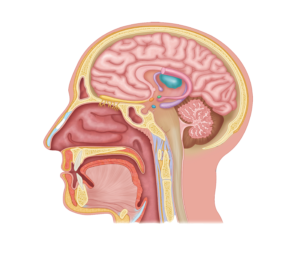The Pineal Gland and Ayahuasca: The Gateway to the Spiritual World
The pineal gland, also known as the epiphysis or pineal gland, is more than a hormone-producing gland of the endocrine system. The endocrine system is our hormonal system, it consists of several glands and organs that produce hormones. In spiritual and mystical traditions, the pineal gland is often referred to as the “seat of the soul” or the “third eye.” Their unique location in the diencephalon, their connection to consciousness, and their possible role in visionary states make them an intriguing focus for studies of Ayahuasca, the sacred Amazonian plant potion.
What is Ayahuasca?
Ayahuasca is a traditional brew used by indigenous people of the Amazon for thousands of years to promote spiritual healing, self-knowledge, and profound shifts in consciousness. The potion consists of two main ingredients:
- Banisteriopsis caapi, a vine that contains MAO inhibitors.
- Psychotria viridis, a plant that provides DMT (dimethyltryptamine).
DMT, also known as the “molecule of consciousness,” is a substance that is often associated with the pineal gland. It is believed that the cells in the pineal gland may produce DMT themselves in certain conditions.
The connection between the pineal gland and Ayahuasca
The role of the pineal gland in visionary states
The pineal gland has a unique position in the body as it performs both endocrine and neurological functions. Its location in the epithalamus (as shown in the picture) and its ability to respond to light stimuli and hormonal cycles have made it a central topic in the study of altered states of consciousness.
- Melatonin and DMT: While the pineal gland primarily produces the hormone melatonin, it is speculated that it may also secrete DMT under special circumstances. The pineal gland produces our happiness hormone, serotonin, during the day and the sleep hormone, melatonin, at night.
- Spiritual Opening: Ayahuasca can promote deep visions and transformative insights through activating the pineal gland.
Ayahuasca and activating the pineal gland
During the Ayahuasca experience, many participants report intense visions, often described as a “spiritual journey.” The pineal gland plays a key role in this.
- Higher states of consciousness: the activity of the pineal gland is stimulated by the DMT from Ayahuasca, allowing access to expanded levels of perception.
- Interaction with the pineal gland: DMT acts on the cells in the pineal gland and thus influences their function.
- Synchronization with the nervous system: the pineal gland has both hormonal and neuronal functions. Ayahuasca can promote the synchronization of these functions and thus support the integration of body, mind and soul.
- Influence on our happiness hormone: Participants repeatedly report increased states of happiness in their process during the Ayahuasca ceremony. This is because the pineal gland produces melatonin, the happiness hormone.
Ayahuasca experiences and their connection to the pineal gland
Participants in Ayahuasca ceremonies often report experiences that are closely linked to the symbolism and function of the pineal gland:
1. Visions and the “Third Eye”
Many people describe processes that go beyond conceptual thinking. For example, visions of light, shapes or symbolic scenarios that are accompanied by inner clarity. These visions are often associated with the activation of the “third eye,” which in spiritual traditions is attributed to the pineal gland.
2. Sense of unity and universal connection
Another common experience is a strong feeling of unification with the universe. This feeling could be due to the activation of neural networks by the pineal gland and DMT, which dissolves the feeling of separation and allows for expanded consciousness.
3. Profound insights and healing
Releasing repressed emotions and processing trauma are central elements of the Ayahuasca experience. The pineal gland could serve as a mediator between physical and spiritual healing processes, as it acts as a bridge between the nervous system and hormonal control. It is the connection between the mystical and the material world.
Scientific Perspectives: Ayahuasca, Pineal Gland and DMT
Does the pineal gland produce DMT?
Although not proven scientifically, there is evidence that the pineal gland could produce DMT by itself under certain circumstances (e.g. in darkrooms). Studies show that enzymes responsible for the synthesis of melatonin may also be involved in the production of DMT.
Ayahuasca and neuroplasticity
Neurological studies show that Ayahuasca can promote neuroplasticity, the brain’s ability to form new connections. Since the pineal gland is closely connected to the nervous system and other parts of the brain, it could play a central role in this.
Melatonin-DMT ratio
The interaction between melatonin and DMT is another field of research. While melatonin has a relaxing effect and promotes sleep, DMT could enable access to intense, visionary states during an Ayahuasca ritual. This balance may be controlled by the function of the pineal gland.
The Spiritual Significance of the Pineal Gland in Ayahuasca Traditions
Indigenous shamans view the pineal gland as the spiritual core of the human being. In many cultures it is revered as a gateway to the spiritual world. In Ayahuasca ceremonies, the “sacred brew” not only acts on the body, but also on the pineal gland to open spiritual perception.
The pineal gland as a gateway to Ayahuasca experiences
The pineal gland is a fascinating organ/gland system that plays a central role in both anatomy and spiritual practices such as Ayahuasca ceremonies. Its function as a gland of the endocrine system and its ability to influence mind-expanding substances such as DMT make them a key to profound transformations.
Ayahuasca not only activates the hormonal balance of the pineal gland, but through this stimulation it also enables spiritual insights, emotional healing and a deeper connection to the universe and the activation of the happiness hormone – serotonin. By supporting the health of the pineal gland, we open ourselves to the possibilities it can offer us in conjunction with Ayahuasca and other spiritual insights.
FAQ
Here you will find all the answers to the questions we receive most frequently.
What does the pineal gland have to do with Ayahuasca?
The pineal gland, also known as the epiphysis or pineal gland, is often referred to as the “spiritual center” of the brain. It plays an important role in the production of hormones such as melatonin and is associated with the release of DMT (dimethyltryptamine). Ayahuasca, a drink from the Amazon region, contains DMT and can induce visionary states. Ayahuasca stimulates the activity of the pineal gland, enabling deep spiritual experiences.
Can the pineal gland really produce DMT?
There is evidence that the pineal gland is capable of synthesizing DMT. It has already been scientifically proven that DMT is a special molecule produced by the body, which is also contained in Ayahuasca, and can cause extraordinary states of consciousness through its interaction with the brain.
How can I activate and cleanse my pineal gland?
Pineal gland activation is often associated with spiritual practices such as meditation, yoga, and breathing exercises. For cleaning it is recommended:
- Avoid fluoride and other toxins as they contribute to calcification of the pineal gland.
- Maintain a diet high in antioxidants (e.g. turmeric, cocoa, green vegetables).
- Perform regular detoxification treatments to remove heavy metals from the body.
- Ayahuasca can also have an activating effect on the pineal gland, but should only be used under professional guidance.


